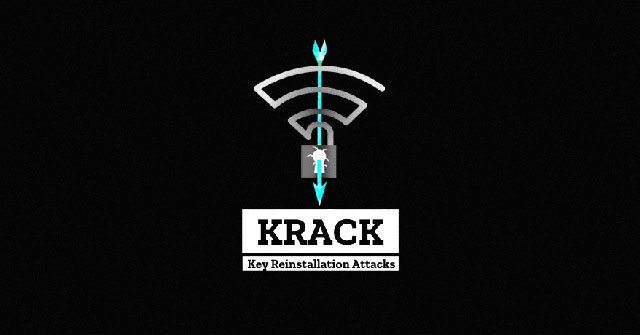KRACK attack breaks down the WPA2 WiFi protocol
Researcher Mathy Vanhoef from Leuven University discovered a serious security flaw on Wi-Fi Protected Access II (WPA2) network security protocol, the most commonly used protocol for WiFi security today. .
Named KRACK, short for Key Reinstallation Attack, this attack uses some key management vulnerabilities on WPA2, allowing 'eavesdropping' of traffic between the computer and WiFi access point, forcing people in the WiFi network to install re-encrypt key used for WPA2 traffic.
The attacker can then steal personal information and note that the hacker does not change the password but can encrypt the data without knowing the password. It means that even if you change your password, it will not prevent KRACK.
 KRACK attack breaks down the WPA2 WiFi protocol Picture 1
KRACK attack breaks down the WPA2 WiFi protocol Picture 1
Error on WiFi WPA2 security protocol helps hackers penetrate network traffic
This error is on the WPA2 protocol itself, not with any software or hardware. 'If your device has WiFi support, it's probably affected too,' the researchers said. According to initial reviews, Android, Linux, Apple, Windows, OpenBSD, MediaTek, Linksys or IoT devices are all affected.
How does KRACK WPA2 work?
KRACK exploits WPA2's 4-step handshake protocol, which is used to set up key for encrypting traffic. In order for a hacker to succeed, the victim will need to reinstall the currently used key, obtained by modifying the handshake message to encrypt.
In addition, the attacker must also be in the above WiFi network. HTTPS in some cases can protect traffic for using another encryption layer, but it is also 100% unsafe because an attacker can downgrade the connection, giving access to encrypted HTTPS traffic.
This attack allows a third party to eavesdrop on WPA2 traffic, but if WiFi uses WPA-TKIP or GCMP encryption, the attacker can also inject malicious code into the victim's packet to fake traffic.
To find out more, you can read the website about this type of attack at https://www.krackattacks.com/
Below is a list of key management vulnerabilities on WPA2 protocol.
CVE-2017-13077
CVE-2017-13078
CVE-2017-13079
CVE-2017-13080
CVE-2017-13081
CVE-2017-13082
CVE-2017-13084
CVE-2017-13086
CVE-2017-13087
CVE-2017-13088
See also: Microsoft silently patched the KRACK WPA2 security hole
You should read it
- What is WPA2 (WiFi Protected Access 2)?
- Wifi security: should use WPA2-AES, WPA2-TKIP or both?
- How to hack WiFi passwords with holes on WPA / WPA2
- Microsoft silently patched the KRACK WPA2 security hole
- Learn about WPA3, the latest WiFi security standard today
- Discover Dragonblood security vulnerability in WPA3
- Discover new ways to hack WPA3 protected WiFi passwords
- How to secure WiFi network, increase security for WiFi
- Instructions for use and security of Wifi network
- Wi-Fi security is better than hiding the SSID
- Secure WiFi in enterprise environment from basic steps
- How easy is Crack WiFi?
May be interested

Opening a dangerous malware store can clean up your bank account on the black web

Microsoft hid the hacking of data in 2013

Sockbot malware was discovered in applications on Google Play Store

Students are expelled for using keyloggers to correct scores

The unpatched Microsoft Word DDE vulnerability is exploited in a massive malware attack

LokiBot - bank trojan on Android turns into ransomware when you try to delete it






 Microsoft silently patched the KRACK WPA2 security hole
Microsoft silently patched the KRACK WPA2 security hole What is WPA2 (WiFi Protected Access 2)?
What is WPA2 (WiFi Protected Access 2)? Wifi security: should use WPA2-AES, WPA2-TKIP or both?
Wifi security: should use WPA2-AES, WPA2-TKIP or both? How to hack WiFi passwords with holes on WPA / WPA2
How to hack WiFi passwords with holes on WPA / WPA2 The new WPA3 WiFi standard was officially released
The new WPA3 WiFi standard was officially released Learn about WPA3, the latest WiFi security standard today
Learn about WPA3, the latest WiFi security standard today